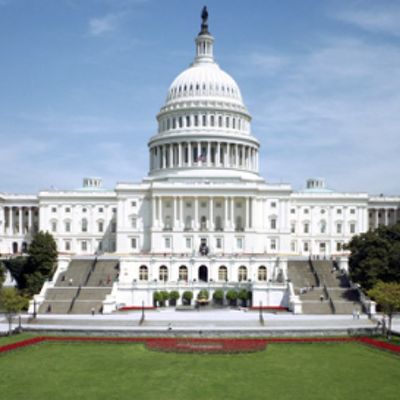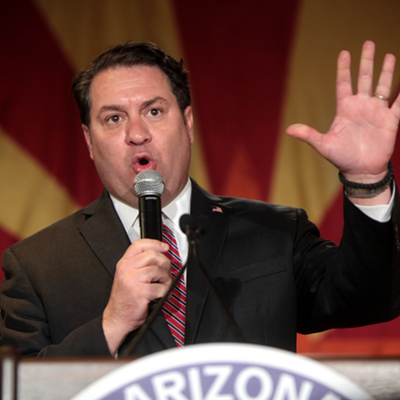A STATELY PLEASURE DOME
Now that they're flush with all that Rio Nuevo money, the Tucson City Council has to decide whether to build that downtown arena, which could cost anywhere from $100 million to $200 million. Of course, that $200 million option would place it on a bridge over Interstate 10.We kid, we kid. No, it just would cost a lot to build a shiny new arena to replace that drab, Soviet-inspired bunker that now squats downtown. The new arena will be so shiny, the boosters tell us, the city will be able to sell luxury boxes and advertising banners that are now out of the question. We'll also get all sorts of overpriced rock 'n' roll spectacles that now pass our little burg by.
Plus, if the arena is built in a new location, we'll be able to expand the Tucson Convention Center complex to allow for more convention space.
On the negative side, the current Tucson Convention Center complex has been a steady drain on the city's general fund, despite the optimistic predictions of city officials who have left taxpayers subsidizing TCC. And if City Manager Mike Hein really thinks that a hockey team is going to succeed as an anchor tenant, he hasn't been paying attention to the poor old Sidewinders, our Triple-A baseball franchise that couldn't even draw a full house during a championship series this year.
The council could always decide to rehab the existing arena, but then the facility would be out of commission for a year or two, which wouldn't be all that good for regular tenants such as the gem show or the Icecats.
WINNERS' CIRCLE
It's starting to feel like necrophilia, but let's take one more poke around Election '06 with the help of Arizona State University pollster Bruce Merrill, who released the results of a post-mortem poll last week.Merrill, who surveyed 962 registered voters in the wake of the Nov. 7 election for Maricopa County PBS affiliate KAET-TV and the ASU journalism school, discovered that it wasn't just no-good secular humanists who voted for Gov. Janet Napolitano. En route to her 27-percentage-point win over Len Munsil, Napolitano picked up the support of 60 percent of church-goers, 53 percent of pro-lifers, 40 percent of self-described political conservatives, 40 percent of Republicans and 80 percent of independents.
Merrill concluded that Napolitano crushed Munsil for three reasons: "First, voters who are angry about the war and recent Republican scandals supported Democratic candidates. Second, voters in Arizona overwhelmingly felt that the governor has done an excellent job for the state of Arizona. Third, partially because he was running as a Clean Elections candidate, Len Munsil had neither the financial resources nor the time he needed in order to become a well-known candidate."
Merrill also examined why Sen. Jon Kyl beat Democrat Jim Pederson by 10 percentage points. Although Pederson got a majority of "political independents and political moderates," he failed to stem a tide of defecting Democrats. With 21 percent of Democrats voting for Kyl and just 10 percent of Republicans supporting Pederson, Kyl cruised to re-election.
"Kyl won because he was successful in appealing to traditional Republican and socially conservative voters," Merrill noted in a release. "He was effective in convincing voters that he has done a good job for Arizona. We also found that those who made up their minds the last week of the campaign or on Election Day voted disproportionately for Kyl. It appears that Pederson's campaign was not effective in telling Arizona voters why they should vote for him rather than against Kyl."
We'd add one thought to both those races: As Jules Winnfield noted in Pulp Fiction: "Personality goes a long way."
CLEAN BREAKDOWN
The Clean Elections Institute--which is sort of the bodyguard of the Clean Elections Commission--fired off a press release last week crowing about the many success stories of the publicly financed campaign program in the '06 election and declaring that "it's clear that Arizona wins with Clean Elections."The folks at the institute point out that six of the eight statewide races--governor, secretary of state, attorney general, superintendent of public instruction, mine inspector and one of the Corporation Commission seats--were won by Clean Elections candidates. What they don't point out is that each of those, with the exception of the unopposed mine inspector, were also won by incumbents.
There's a reason for that: Clean Elections doles out less than $120,000 for the primary and general elections combined to each candidate for treasurer, superintendent of public instruction and the Arizona Corporation Commission. That's barely enough for a couple of mailers to all the registered voters in the state, which gives a big advantage to candidates who have name ID--in other words, the candidates who are already holding office. Even for offices such as attorney general and secretary of state, the amount of money is absurdly low, so Clean Elections is basically an Incumbent Protection Act for statewide offices.
The act does provide enough money to run a reasonable race for the Legislature, where nine out of 30 senators and 28 out of 60 representatives won using Clean Elections. We're still skeptical about whether that's a good thing, mainly because we remain concerned about how social conservatives in the Republican Party, who were traditionally held in check by business-friendly Republicans, have been making headway with Clean Elections bucks.
But we're delighted to see that--at least in Pima County--two conservatives who won GOP primaries went down to defeat on Election Day. Up in GOP-dominated Legislative District 26, which includes the Catalina Foothills, Oro Valley and Saddlebrooke, Democrat Lena Saradnik took out Republican David Jorgenson in the House race, while Democrat Charlene Pesquiera knocked out Republican Al Melvin. Pesquiera, who didn't qualify for Clean Elections, had to raise money the dirty ol' traditional way and got plenty of help from one of those rotten independent campaign committees--and we'd say that Arizona won with her victory.
Given that Pesquiera had never even voted before running this year and only got into the race on a lark about a week before nomination petitions were due, her win must be grating not only to Melvin, but to other would-be politicos who have plotted and schemed for years to get into the Legislature.
WASTEWATER IS FOR FIGHTING
There's a new water war brewing down in the town of Sahuarita between mega-developer Bob Sharpe and the State Land Department.Sharpe is trying to get an initiative on the town ballot that would require voter approval for any new developments to use the wastewater treatment plant that now serves his kingdom of Rancho Sahuarita.
That's not making the gang at the Land Department very happy, because they have a 600-acre parcel just west of Rancho Sahuarita that they'd like to sell in the future. If Sharpe's initiative is successful, it could have an affect on the land's value, as Assistant Attorney General David F. Jacobs noted in a recent letter to Sharpe's legal team.
"The uncertainty and additional process caused by the initiative would greatly increase the expense of new development and likely decrease the value of the state trust parcel and all neighboring land," Jacobs wrote.
Could that be Sharpe's plan--lower the interest in bidding on the property so he can get it cheaper when it hits the auction block? Now that's seeing your opportunities and taking them.
Jacobs pointed out in his letter that Sharpe should think twice about continuing with the initiative, pointing out that if Sahuarita voters didn't allow the future developer of the state land parcel to use the current wastewater plant, they'd probably build a new one right next door to Rancho Sahuarita, which might be less efficient--and more stinky?--than the existing one.
"Ultimately, the quality of wastewater service would decrease, and more, not fewer, Rancho Sahuarita residents would be impacted," warns Jacobs.












